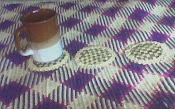Sewing by hand is an alternative way to sew cushions, this will take longer but the end result is a very special cushion, made and crafted without the use of a machine.
Personalising your cushion covers with patchwork can be done by machinesewing or sewing by hand.
Even when using a machine for sewing cushions there are a few steps that need hand sewing. An example would be sewing on sequins, braid or buttons.
Types of Stitches for Hand Sewing
- Tacking stitch- This stitch is also known as basting stitch. This is used when two pieces of material need to be held together for a short time while the seam is sewn. This could be used for holding any applique patterns in place to make sure that they do not move.The stitches are usually long in length, usually sewn from right to left, and can be easily removed when the finshed sewing has taken place.
- Running Stitch- This stitch is used when material is needed to be gathered up as with frills or ruffles. The stitch is similar to tacking stitch but the stitch length is smaller and neater. This is to get even gathers as if the length was too large or varying then the gathers would be different sizes. This stitch is also usually sewn from right to left.
- Back Stitch- This stitch is a strong stitch and is good for sewing seams. This is usually sewn from left to right and gives a line of stitches on the top that overlap underneath.
- Slip Stitch- This stitch is usually used when two edges of fabric need to be joined such a along a folded corner or when joining patchwork pieces by hand. These stitches are not sewn tightly to allow for a little movement.
- Blanket Stitch- This stitch is a decorative stitch and is usually seen along the edge of a blanket. It is usually sewn from left to right.
- Overcasting Stitch- This stitch is used to stop the fabric edges from fraying.
- Hemming- This stitch is sewn on the wrong side of the fabric and small stitches are used with just a thin thread taken from the fabric and then into the hem. This is to make sure that the hemming stitch is not seen on the right side of the item.
